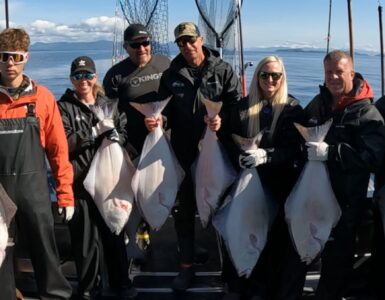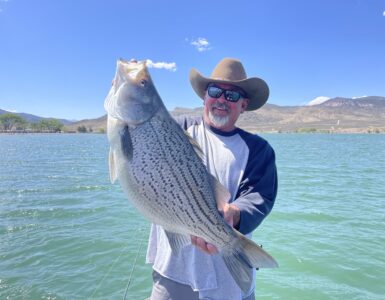Thanks for tuning into KSL Outdoors, I’m Adam Eakle. Tonight we are going to show you a couple of projects the DWR is working on in two of Utah’s favorite reservoirs and we are kicking it off at Willard Bay.
It’s a sight never seen on Willard Bay. A dump truck, floating on a barge, loaded with ten tons of rock on it’s way to make a big splash for both anglers and fish.
We are creating habitat in places where it is obviously lacking.
Willard Bay is a freshened arm of Great Salt Lake. It has all of the features of a marsh bottom. Well it doesn’t create a lot of good habitat for fish that way. So what we are doing is adding something unique to the typical structure here of flat mud.
We are putting boulders in, it gives the fish a place to orient to. It gives their prey items, the beginnings of their food web a place to colonize, create a home, so the predatory fish can come in and have an all you can eat buffet.
In two weeks, over five hundred tons of boulders were deposited, creating a rocky reef if you will. The acre size feature is located about a half mile off shore, just south of the south marina opening.
We wanted to make it accessible, at least in times of good weather for the non-motorized boating crowd, the kayaks and the kick boats that are becoming increasingly popular so we are not really focusing on a singular user group, that being people with boats.
A week after the project was finished we went out with Kent to see if the fish had found the rocks.
First I want to go over the structure and take a look at it with the electronics, see if I can document any fish literally using it being there at present and then we’ll try and catch them.
This side scan sonar shows that off to our left there is three different dump truck loads off here is some off to our right? 1,2,3,4,5,6 of them off to our right.
Each of these individual white spots is a dump truck load. Some of them are touching, some of them are discreet.
We are going to experience a lot of aquatic insects and a lot of crayfish and that will in turn bring in fish that prey on them and those will bring in fish that prey on those fish. So we are basically starting a little ecosystem out here.
This is a fish echo, over the top of one of the rock piles.
So we deployed our worm harness, behind a bottom bouncer to see if we could catch one.
I’ve got something hitting me here. There he is. Fish on. Feels like a wiper.
Right off the edge of that structure. Come on be a big one. I don’t know it’s staying down like a…I don’t know what it is.
No it’s a channel cat. Channel cat and it’s a good one. Yea it is. Oh look at that toad. Look at that pig. That’s cool. I didn’t know that… First channel cat I’ve ever caught in here.
I hope it’s widely successful. Not for my own selfish reason. I hope we can come up with a technique that works on flat waters consistently.
I don’t know what it is, but he slammed it. I think I know what it is.
yup, first wiper of the day. Look at that, nice fish. He just hammered it. nice healthy fish. Right off that rock pile.
If you build it. They will come huh?
We know rivers, we build rivers all the time and mess with those. So the guys that fish rivers are getting a lot of value for their license dollars with return with habitat projects, but the guys who fish lakes, the reservoirs, haven’t been getting the same percentage of returns so if we have a technique like this that we can prove works. Can provide that consistent fishing. I think we’ve gone a long ways of serving our client base a lot better.
Is he still there? Yup.
Oh yeah that’s a walleye. Is it flopping around on top. No but I’m calling it.
it’s a walleye, good walleye. They are all good.
Boy he did, he wasn’t getting off.
Well like you said if you build it. They will come. We caught a few fish there and you expect more in the future. Oh yeah. Once the fish figure out it’s there, they colonize it, they’ll stay longer and maybe make a home of it. More information on the reefs, where can they find those. We will have the coordinates on our DWR website, Parks and Recreation, you can call the park or look on their website. Rocky Mountain Anglers will have it. They helped fund the project. Yea, absolutely.
You know there is a lot of DWR projects right now going on and one that is three years in the making is aimed at helping our neighbors up in Wyoming with their smallmouth population at Flaming Gorge.
First of all I wanted to thank everybody for coming out to help us with this event.
Dozen of anglers showed up to help the Utah DWR and the Wyoming Game and Fish move an abundance of smallmouth bass found on the Utah side of Flaming Gorge Reservoir to the Wyoming side where smallmouth bass are in trouble.
Smallmouth bass in the Wyoming portion of the gorge are struggling.
Biologists believe the reason smallmouth are struggling is because of the illegally introduced burbot found in abundance now especially on the Wyoming side of the reservoir.
The smallmouth bass were kinda hit on two fronts. One is they eat primarily crayfish and burbot also eat a lot of crayfish and then the wintertime when burbot are more active and smallmouth bass are more dormant the smallmouth bass are being predated on by the burbot.
That’s like the ones we are after right there.
Bubba O’Neill has helped out with this event now for three years.
We believe the future of smallmouth is really dependent on not only the eradication of the burbot. But also the restocking of those areas with these smaller fish that are not being bothered by the burbot population.
bubba got one. Little fatty. I mean they are fat little buggers, they must be eating the little bass fry that are in there.
Cute little bugger, future four pounder. That’s the goal. Doubles.
Two years ago Flaming Gorge made the top 100 bass lakes in the entire country. Now we are not on that list anymore and there is a lot of reasons for that.
Little bigger one there.
And the biggest reason is the decimation. I believe, the decimation of the smallmouth fishery by the burbot.
Got one? Oh a good one. That’s a 12 incher isn’t it?
Once anglers live wells were full.
I’m going to let you dump those.
The fish were then taken to the DWR where they were.
Seven point four, no tag.
measured, and tagged.
for a future smallmouth bass study. They were then loaded up and boated to Wyoming.
I think the public understands what we are trying to accomplish. We want to maintain this smallmouth bass fishery as much as possible into the future. This is just one step towards that goal.
Another step that Wyoming has taken to protect smallmouth bass is they’ve proposed a catch and release regulation change for the Wyoming side of the gorge for 2017. The proposed change was supported by the public and now is waiting for approval by the Wyoming Game and fish commission. Bass are still abundant on the Utah side of the reservoir, specifically in the Canyon region, and Utah is keeping it’s ten fish limit for now.
The most important thing to me is it looks like the game and fish really cares.
They are proving it to the public, they are letting us get actively involved which I think is important.
Oh, coach got one!
Because I’m going to take care of something that,
Whoo Hoo!
I feel I have ownership in and I feel ownership of the smallmouth fishery along with thousand of other people.
We own it and we need to take care of it and they are helping in a joint cooperation, they are helping to make sure that this fishery last for the next 100 years.
Ryan was saying that the anglers exceeded his expectations this year. Last year they caught about a thousand fish, this year they actually topped that, 1400 smallmouth moved to Wyoming. It’s a great time of year to get up to Flaming Gorge. Chase kokanee in the morning, smallmouth in the afternoon and maybe go after some lakers as well.
Well we’ve moved to Antelope Island State Park known for bison of course, antelope, deer, even big horn sheep. Tonight we are going to show you an animal I’ll bet you may have seen but maybe not this close.
So tonight we are going to run a bat survey.
What we use are what is called mist nets. The other way we put out ultrasonic microphones.
We’ve invited public out to kind of see what we are doing and to learn about bats but it’s also part of a statewide survey that we conduct. To track species distributions and populations throughout the state.
Most likely we’ll get one of a few different species, the Brazilian free-tail bat, maybe Townsend’s Big eared bat, maybe a bat called the big brown bat, which is a very descriptive name.
To capture bats, biologists use these mist nets. These nets capture the bats without hurting them.
Bats tend to come out only when it’s the darkest of darkest. They echo locate and can navigate in the complete absence of light. That’s how they find their way through caves and things like that. For that reason a lot of people think they are blind, but they are not. Bats actually can see just as well as we can.
It takes awhile but soon we have bats in the net.
there’s one.
Some with really big ears.
He’s got some sharp teeth too.
oh it’s a Townsends? Yeah we’ve got four.
These are Townsend’s big eared bats.
The main thing that really sets them apart is the length of the ears.
There is a couple of other species that have long ears like this. but if you can see right down on the face. There is these two glands that stick up above it’s nose. That’s what really identifies it as the Townsend’s.
These bats are mostly associated with caves and mines.
I got a male. do you? yea. non reproductive.
Another species caught is one called a little brown bat.
The wing membrane connects all their fingers together. So their hand is shaped very much like ours. Their thumb sticks up with a little claw hook on it and their membrane stretches between their finger digits.
Yeah that one he caught, was really something to see. I haven’t seen one up close like that.
very delicate, but they are amazing creatures.
Once documented, the bats are released back into the wild.
I love this. I’ve got a permanent grin on my face.
Boy that is pretty cool. Townsend’s Big Eared bat and there he goes.
It was feast or famine. Boy we didn’t have any bats there, but once it got dark. Yeah it was really quite. It did, it got a little bit darker, the wind seemed to calm down a little bit. We got hit with four bats all at once, two more came after right real quick. Pretty cool.







Add comment